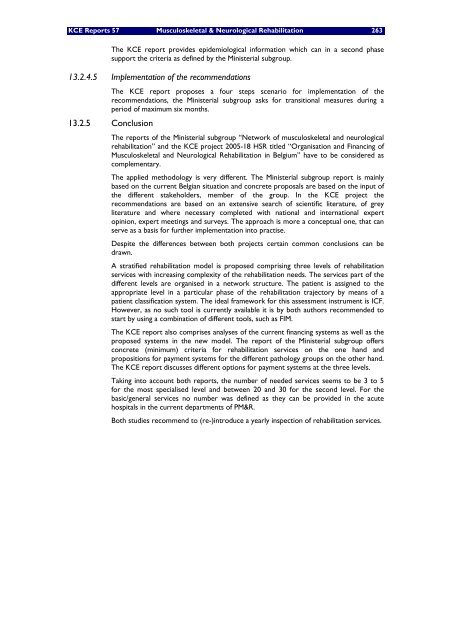The report is available in English with a French summary - KCE
The report is available in English with a French summary - KCE
The report is available in English with a French summary - KCE
Create successful ePaper yourself
Turn your PDF publications into a flip-book with our unique Google optimized e-Paper software.
<strong>KCE</strong> Reports 57 Musculoskeletal & Neurological Rehabilitation 263<br />
<strong>The</strong> <strong>KCE</strong> <strong>report</strong> provides epidemiological <strong>in</strong>formation which can <strong>in</strong> a second phase<br />
support the criteria as def<strong>in</strong>ed by the M<strong>in</strong><strong>is</strong>terial subgroup.<br />
13.2.4.5 Implementation of the recommendations<br />
<strong>The</strong> <strong>KCE</strong> <strong>report</strong> proposes a four steps scenario for implementation of the<br />
recommendations, the M<strong>in</strong><strong>is</strong>terial subgroup asks for transitional measures dur<strong>in</strong>g a<br />
period of maximum six months.<br />
13.2.5 Conclusion<br />
<strong>The</strong> <strong>report</strong>s of the M<strong>in</strong><strong>is</strong>terial subgroup “Network of musculoskeletal and neurological<br />
rehabilitation” and the <strong>KCE</strong> project 2005-18 HSR titled “Organ<strong>is</strong>ation and F<strong>in</strong>anc<strong>in</strong>g of<br />
Musculoskeletal and Neurological Rehabilitation <strong>in</strong> Belgium” have to be considered as<br />
complementary.<br />
<strong>The</strong> applied methodology <strong>is</strong> very different. <strong>The</strong> M<strong>in</strong><strong>is</strong>terial subgroup <strong>report</strong> <strong>is</strong> ma<strong>in</strong>ly<br />
based on the current Belgian situation and concrete proposals are based on the <strong>in</strong>put of<br />
the different stakeholders, member of the group. In the <strong>KCE</strong> project the<br />
recommendations are based on an extensive search of scientific literature, of grey<br />
literature and where necessary completed <strong>with</strong> national and <strong>in</strong>ternational expert<br />
op<strong>in</strong>ion, expert meet<strong>in</strong>gs and surveys. <strong>The</strong> approach <strong>is</strong> more a conceptual one, that can<br />
serve as a bas<strong>is</strong> for further implementation <strong>in</strong>to pract<strong>is</strong>e.<br />
Despite the differences between both projects certa<strong>in</strong> common conclusions can be<br />
drawn.<br />
A stratified rehabilitation model <strong>is</strong> proposed compr<strong>is</strong><strong>in</strong>g three levels of rehabilitation<br />
services <strong>with</strong> <strong>in</strong>creas<strong>in</strong>g complexity of the rehabilitation needs. <strong>The</strong> services part of the<br />
different levels are organ<strong>is</strong>ed <strong>in</strong> a network structure. <strong>The</strong> patient <strong>is</strong> assigned to the<br />
appropriate level <strong>in</strong> a particular phase of the rehabilitation trajectory by means of a<br />
patient classification system. <strong>The</strong> ideal framework for th<strong>is</strong> assessment <strong>in</strong>strument <strong>is</strong> ICF.<br />
However, as no such tool <strong>is</strong> currently <strong>available</strong> it <strong>is</strong> by both authors recommended to<br />
start by us<strong>in</strong>g a comb<strong>in</strong>ation of different tools, such as FIM.<br />
<strong>The</strong> <strong>KCE</strong> <strong>report</strong> also compr<strong>is</strong>es analyses of the current f<strong>in</strong>anc<strong>in</strong>g systems as well as the<br />
proposed systems <strong>in</strong> the new model. <strong>The</strong> <strong>report</strong> of the M<strong>in</strong><strong>is</strong>terial subgroup offers<br />
concrete (m<strong>in</strong>imum) criteria for rehabilitation services on the one hand and<br />
propositions for payment systems for the different pathology groups on the other hand.<br />
<strong>The</strong> <strong>KCE</strong> <strong>report</strong> d<strong>is</strong>cusses different options for payment systems at the three levels.<br />
Tak<strong>in</strong>g <strong>in</strong>to account both <strong>report</strong>s, the number of needed services seems to be 3 to 5<br />
for the most special<strong>is</strong>ed level and between 20 and 30 for the second level. For the<br />
basic/general services no number was def<strong>in</strong>ed as they can be provided <strong>in</strong> the acute<br />
hospitals <strong>in</strong> the current departments of PM&R.<br />
Both studies recommend to (re-)<strong>in</strong>troduce a yearly <strong>in</strong>spection of rehabilitation services.

















